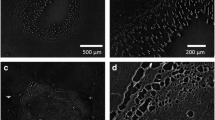Abstract
Sol–gel-based materials were synthesized, characterized and finally tested as solid supports for desorption electrospray ionization-mass spectrometry (DESI-MS) analysis of a mixture of compounds of different polarity. Films with thickness in the 2–4 μm range were obtained by a dip-coating process using tetraethoxysilane (TEOS) and octyltriethoxysilane (OTES) as sol–gel precursors. Three types of surface with different hydrophobic character were obtained by varying the TEOS/OTES ratio in the sol–gel mixture. Each coating was characterized by atomic force microscopy investigations, gaining insight into homogeneity, smoothness and thickness of the obtained films. To study hydrophobicity of each surface, surface free energy measurements were performed. Different DESI-MS responses were observed when different solvent mixture deposition procedures and solvent spray compositions were investigated. Results were finally compared to those obtained by using commercial polytetrafluoroethylene-coated slides. It was found that surface free energy plays an important role in the desorption/ionization process as a function of the polarity of analytes.







Similar content being viewed by others
References
Takats Z, Wiseman JM, Cooks RG (2005) Ambient mass spectrometry using desorption electrospray ionization (DESI): instrumentation, mechanisms and applications in forensics, chemistry, and biology. J Mass Spectrom 40(10):1261–1275
Venter A, Nefliu M, Cooks RG (2008) Ambient desorption ionization mass spectrometry. Trac-Trend Anal Chem 27(4):284–290
Ifa DR, Jackson AU, Paglia G, Cooks RG (2009) Forensic applications of ambient ionization mass spectrometry. Anal Bioanal Chem 394(8):1995–2008
Cheng SC, Lin YS, Huang MZ, Shiea J (2010) Applications of electrospray laser desorption ionization mass spectrometry for document examination. Rapid Commun Mass Spectrom 24(2):203–208
Wu C, Qian K, Nefliu M, Cooks RG (2010) Ambient analysis of saturated hydrocarbons using discharge-induced oxidation in desorption electrospray ionization. J Am Soc Mass Spectrom 21(2):261–267
Manicke NE, Kistler T, Ifa DR, Cooks RG, Ouyang Z (2009) High-throughput quantitative analysis by desorption electrospray ionization mass spectrometry. J Am Soc Mass Spectrom 20(2):321–325
Green FM, Stokes P, Hopley C, Seah MP, Gilmore IS, O’Connor G (2009) Developing repeatable measurements for reliable analysis of molecules at surfaces using desorption electrospray ionization. Anal Chem 81(6):2286–2293
Ifa DR, Manicke NE, Rusine AL, Cooks RG (2008) Quantitative analysis of small molecules by desorption electrospray ionization mass spectrometry from polytetrafluoroethylene surfaces. Rapid Commun Mass Spectrom 22(4):503–510
Kennedy JH, Wiseman JM (2010) Evaluation and performance of desorption electrospray ionization using a triple quadrupole mass spectrometer for quantitation of pharmaceuticals in plasma. Rapid Commun Mass Spectrom 24(3):309–314
Paglia G, Ifa DR, Wu C, Corso G, Cooks RG (2010) Desorption electrospray ionization mass spectrometry analysis of lipids after two-dimensional high-performance thin-layer chromatography partial separation. Anal Chem 82(5):1744–1750
Wu C, Ifa DR, Manicke NE, Cooks RG (2010) Molecular imaging of adrenal gland by desorption electrospray ionization mass spectrometry. Analyst 135(1):28–32
Wiseman JM, Ifa DR, Song Q, Cooks RG (2006) Tissue imaging at atmospheric pressure using desorption electrospray ionization (DESI) mass spectrometry. Angew Chem Int Ed Engl 45(43):7188–7192
Wiseman JM, Ifa DR, Venter A, Cooks RG (2008) Ambient molecular imaging by desorption electrospray ionization mass spectrometry. Nat Protoc 3(3):517–524
Kertesz V, Van Berkel GJ, Vavrek M, Koeplinger KA, Schneider BB, Covey TR (2008) Comparison of drug distribution images from whole-body thin tissue sections obtained using desorption electrospray ionization tandem mass spectrometry and autoradiography. Anal Chem 80(13):5168–5177
Watrous J, Hendricks N, Meehan M, Dorrestein PC (2010) Capturing bacterial metabolic exchange using thin film desorption electrospray ionization-imaging mass spectrometry. Anal Chem 82(5):1598–1600
Chipuk JE, Gelb MH, Brodbelt JS (2010) Surface-enhanced transmission mode desorption electrospray ionization: increasing the specificity of ambient ionization mass spectrometric analyses. Anal Chem 82(1):16–18
Pasilis SP, Kertesz V, Van Berkel GJ (2007) Surface scanning analysis of planar arrays of analytes with desorption electrospray ionization-mass spectrometry. Anal Chem 79(15):5956–5962
Volny M, Venter A, Smith SA, Pazzi M, Cooks RG (2008) Surface effects and electrochemical cell capacitance in desorption electrospray ionization. Analyst 133(4):525–531
Mahltig B, Audenaert F, Bottcher H (2005) Hydrophobic silica sol coatings on textiles—the influence of solvent and sol concentration. J Sol-Gel Sci Techn 34(2):103–109
Pilotek S, Schmidt HK (2003) Wettability of microstructured hydrophobic sol–gel coatings. J Sol-Gel Sci Techn 26(1–3):789–792
Ameduri B, Boutevin B, Moreau JJE, Moutaabbid H, Man MWC (2000) Hybrid organic–inorganic gels containing perfluoro-alkyl moieties. J Fluorine Chem 104(2):185–194
Lin YS, Chen YC (2002) Laser desorption/ionization time-of-flight mass spectrometry on sol–gel-derived 2,5-dihydroxybenzoic acid film. Anal Chem 74(22):5793–5798
Wei Y, Yeh JM, Jin DL, Jia XR, Wang JG, Jang GW, Chen CC, Gumbs RW (1995) Composites of electronically conductive polyaniline with polyacrylate-silica hybrid sol–gel materials. Chem Mater 7(5):969–974
Wu SJ (1971) Calculation of interfacial tension in polymer systems. Polym Sci Part C 34(1):19–30
Hench LL, West JK (1990) The sol–gel process. Chem Rev 90(1):33–72
Feher FJ, Budzichowski TA (1989) J Organomet Chem 373:153–163
Degarmo EP, Black JT, Kohser RA (2003) Materials and processes in manufacturing, 9th edn. Wiley, Hoboken, NJ
Komori Y, Nakashima H, Hayashi S, Sugahara Y (2005) Silicon-29 cross-polarization/magic-angle-spinning NMR study of inorganic-organic hybrids: homogeneity of sol–gel derived hybrid gels. J Non-Cryst Solids 351(2):97–103
Acknowledgements
The facilities of the Centro Interdipartimentale Misure (CIM) “Giuseppe Casnati” (University of Parma) were used to perform AFM investigations. We are grateful to Dr. Carlo Vignali for the skilful assistance. Thanks also to Dr. Andrea Lorenzi and to Dr. Marco Rocchetti for the helpful discussions and suggestions.
Author information
Authors and Affiliations
Corresponding author
Rights and permissions
About this article
Cite this article
Penna, A., Elviri, L., Careri, M. et al. Investigation of novel sol–gel hydrophobic surfaces for desorption electrospray ionization-mass spectrometry analysis. Anal Bioanal Chem 400, 1515–1523 (2011). https://doi.org/10.1007/s00216-011-4867-9
Received:
Revised:
Accepted:
Published:
Issue Date:
DOI: https://doi.org/10.1007/s00216-011-4867-9




